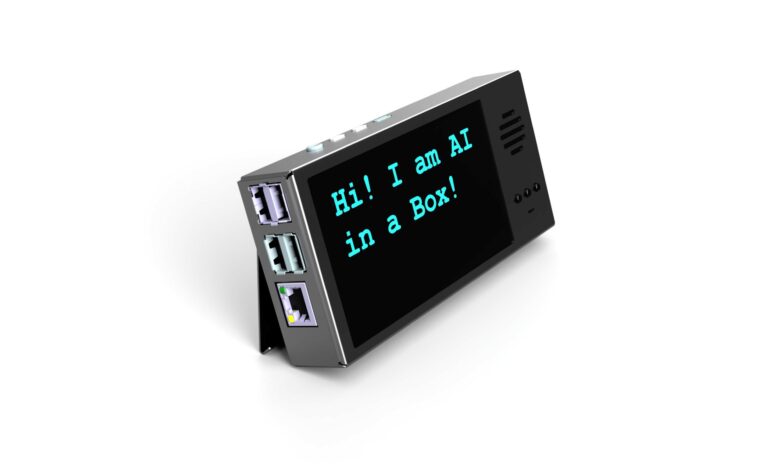TL;DR:
- CrowdSupply introduces the AI in a Box, an offline and open-source LLM device.
- It operates independently without the need for internet, accounts, or subscriptions.
- Powered by RockChip 3588S SoC with 8GB DRAM memory and NPU.
- Utilizes open-source models like Whisper and Llama2 with transparent code.
- Key capabilities include live captions, conversational AI, live translation, and air-gapped privacy.
- Useful Sensors highlight potential limitations in accuracy and reliability.
- The AI in a Box Prototype Kit is priced at $475.00, including essential accessories.
- A standalone AI in a Box device is available for $299.00.
Main AI News:
In the realm of cutting-edge tech, AI in a Box emerges as a formidable contender. Powered by Rockchip technology, this compact, offline, and open-source Local Language Model (LLM) device, recently unveiled by CrowdSupply, promises secure and responsive interactions. What sets it apart is its autonomy—no reliance on internet connectivity, accounts, complex setups, or recurring subscriptions.
At its core, the AI in a Box harnesses the potent RockChip 3588S SoC, complemented by 8GB of DRAM memory and an NPU reminiscent of those found in other Single Board Computers (SBCs) like the Indiedroid Nova and NanoPi R6C, among others. A key distinguishing feature is its utilization of open-source models, notably Whisper and Llama2. Furthermore, the entire codebase, including a library optimized for transformer inference on the RockChip NPU, is made accessible under an open-source license.
Here are some of the standout capabilities packed into the AI in a Box:
- Live Captions: Experience real-time closed captions generated from audio inputs, viewable on the device’s screen or through HDMI for external displays.
- Conversational AI: Engage in text-based interactions with a local Large Language Model (LLM), no setup hassles or API fees involved. It covers a wide array of conversational topics.
- Live Translation: Witness on-the-fly translation between major languages, complete with split-screen captions displaying both the original and translated text.
- Air-Gapped Privacy: Your data remains sacrosanct as the software operates solely within the device. No Wi-Fi or Bluetooth connections are needed, with access via a physical keyboard or Ethernet cable being the exclusive pathway.
- Voice Keyboard: An included USB Type-A cable transforms nearby conversations into keystrokes, facilitating seamless integration with other systems.
- Open Source: Built on open-source models, it not only offers transparency in code but also supports the development of real-time voice input applications in Python, ensuring security and privacy audits are a breeze.
In a recent development, the company unveiled a prototype daughter board, complete with a 5-inch LCD screen, microphone, speaker, and USB emulation—a testament to their commitment to refining the product.
However, it’s important to note that Useful Sensors cautions that “the finished product may not produce results that are accurate or fast enough for all potential use cases.” They further emphasize that “All current AI language models are very good at sounding confident while giving totally wrong answers.” This underscores the need to exercise discretion when relying on the device for factual information.
For those eager to embark on this technological journey, the AI in a Box Prototype Kit is available for $475.00, inclusive of the Rockchip-based device, a 3D printed enclosure, an external display, microphone, speaker, HDMI cable, USB cable, and a power adapter. Shipping costs amount to an additional $8.00 within the US and $18.00 for international destinations. Alternatively, the AI in a Box device can be acquired separately for $299.00, with similar shipping fees applied.
Conclusion:
The AI in a Box, leveraging Rockchip technology and open-source models, marks a significant leap in offline AI capabilities. While its features are compelling, potential accuracy limitations underscore the importance of cautious reliance. Nevertheless, this innovation paves the way for secure, open-source, and offline AI solutions, catering to a niche market seeking autonomy and privacy in AI interactions.

